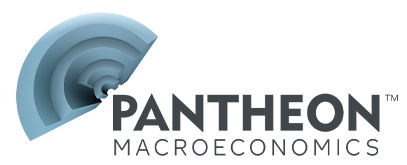US Publications
Below is a list of our US Publications for the last 5 months. If you are looking for reports older than 5 months please email info@pantheonmacro.com, or contact your account rep
Please use the filters on the right to search for a specific date or topic.
- We calculate tariffs have lifted core PCE inflation by 0.4pp, below Mr. Powell’s “five to six tenths” estimate.
- Pass-through, however, is probably just over half complete, and services inflation will fall next year.
- The looming suspension of SNAP benefits could hit GDP by 0.2% if paused through the end of Q4.
- Chair Powell has jolted markets by saying a December easing is “not a foregone conclusion, far from it”...
- ...But most hiring indicators still point to near-stagnant payrolls; post-shutdown data will spur more easing.
- October’s regional Fed surveys point to flat employment demand and slower wage growth ahead.
- Conference Board job availability little changed in October, signalling a mere 50K rise in private jobs.
- New weekly ADP data are likely to mislead to an even greater extent than the long-running monthly series.
- A 25bp easing in the funds rate is almost certain today; Powell to be non-committal amid lack of data.
- Tariff revenues continue to underwhelm; the ending of the de minimis exemption has been uneventful.
- Accordingly, we are shaving 0.1pp off our forecast for the peak in core PCE inflation in December.
- Charts implying a dramatic rise in “different cell” imputation overstate the decline in data quality.
Services inflation likely to remain in check.
Tariffs still pushing goods inflation higher, but services inflation looks soft under the hood.
- Tariffs continue to lift core goods prices; passthrough is now about two-fifths complete…
- …But core services inflation remains in check and the weakening labor market will drag it lower.
- Higher goods inflation will be fleeting, while falling services inflation will enable the FOMC to ease.
Lower mortgage rates boost sales, but major headwinds remain.
- Payroll trends have consistently been a good guide to the economy’s momentum in the past.
- Job growth often responds far more quickly at major turning points than contemperaneous GDP.
- The current near-stagnation in job gains is alarming, despite the relatively healthy economic activity data.
- The year-to-date change in Homebase’s measure of employment is almost identical to last year...
- ...But this also was true in the summer, when payrolls slowed decisively; we track other indicators instead.
- Canada CPI data point to risk of a big increase in US food at home prices in September.
- The regional Fed and PMI surveys are no better at forecasting GDP than just extrapolating the trend.
- Durables goods spending by consumers is reasonably well signalled by the UoM confidence survey.
- Airline passenger and hotel occupancy data are useful for forecasting that segment of spending only.
- The weakening dollar means that DXY is no longer overshooting its long-term link with Treasury yields.
- ...But further fiscal easing and politicization of the Fed are key downside risks for the dollar in 2026.
- Housing inflation likely has further to fall, given the renewed drop in rental growth in recent months.
- Regional banks are under renewed scrutiny, oil prices have tumbled, and the shutdown is going long...
- ...So markets are starting to see a meaningful chance of a 50bp easing in December.
- But timely data imply the labor market and GDP growth are holding up; 25bp is still more likely.
- Homebase data point to steady employment growth, and WARN data indicate layoffs remain low...
- ...But Indeed job postings are falling at a faster pace, and Empire State hiring intentions have weakened.
- High mortgage rates and consumers’ low confidence imply higher homebuilder optimism won’t last.
- Corporate balance sheets look healthy in aggregate; private credit is a small and stable part of the picture.
- Mortgage refinancing is continuing to reverse its mid-September surge; expect low levels next year too.
- The Empire State survey signals renewed impetus in factory gate inflation; fingers crossed it’s an outlier.
Rock-bottom response rate casts doubt over reliability.
- We expect a 0.4% rise in the headline CPI—below the 0.5% priced into swaps—and a 0.3% core print.
- Core goods prices likely were boosted again in September by the tariffs, including new vehicle prices.
- Residual seasonality will lift services prices, but the rebound in airline fares is over, and rent is cooling.
- Consumers’ major purchase intentions have fallen sharply, signalling flat spending on durable goods.
- NRF and Redbook data point to a drop in retail sales in September, ending a strong three-month run.
- Most measures of spending on discretionary services have weakened, consistent with a lackluster Q4.
Shutdown hit limited for now, but strong headwinds remain.
- September’s payroll report likely will be released about three working days after the shutdown ends.
- October payrolls will be unaffected by the shutdown, but the unemployment rate will be lifted by 0.2pp.
- The rotation of the regional Fed voters implies a slight hawkish shift in the FOMC early next year.
